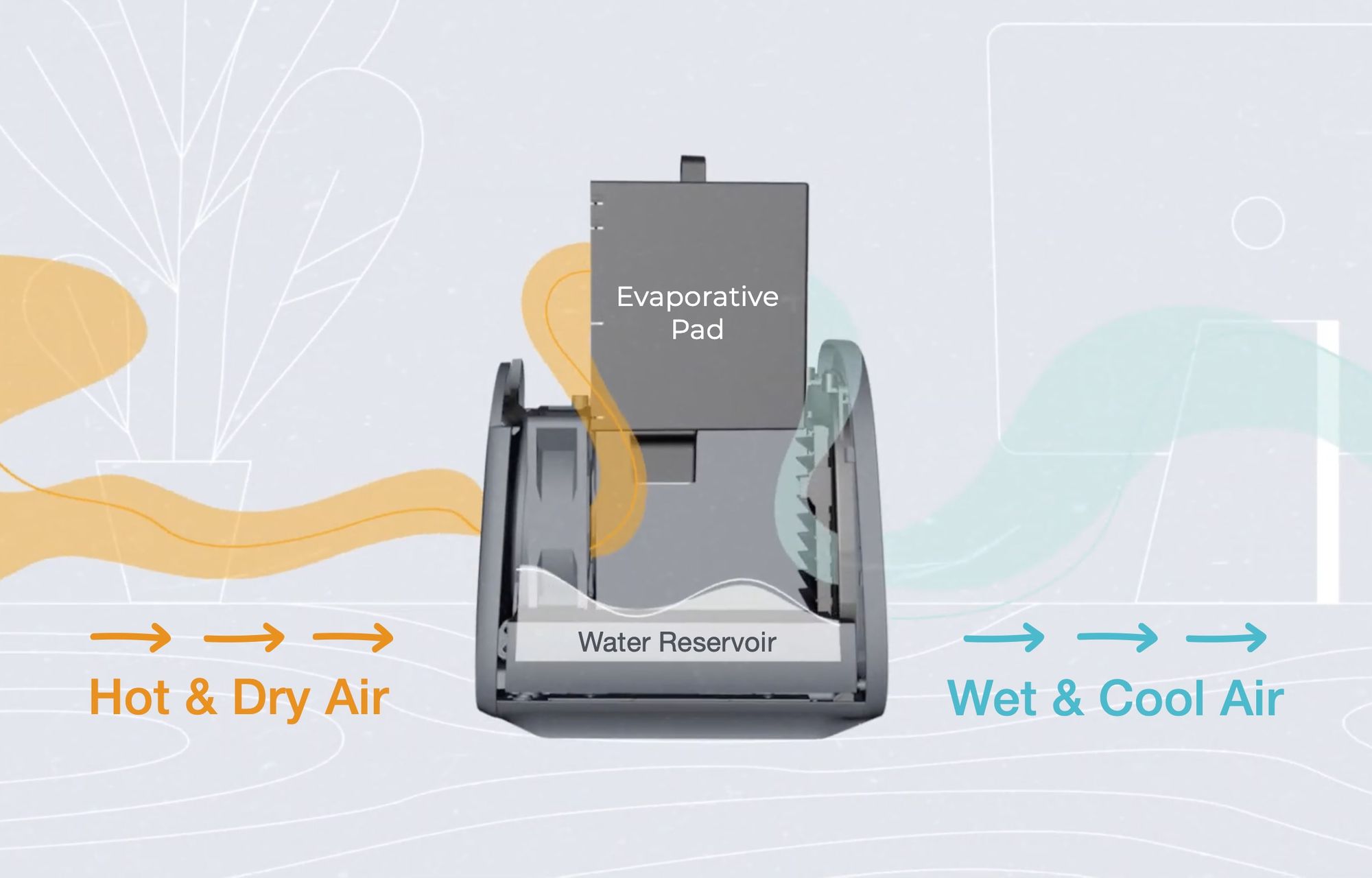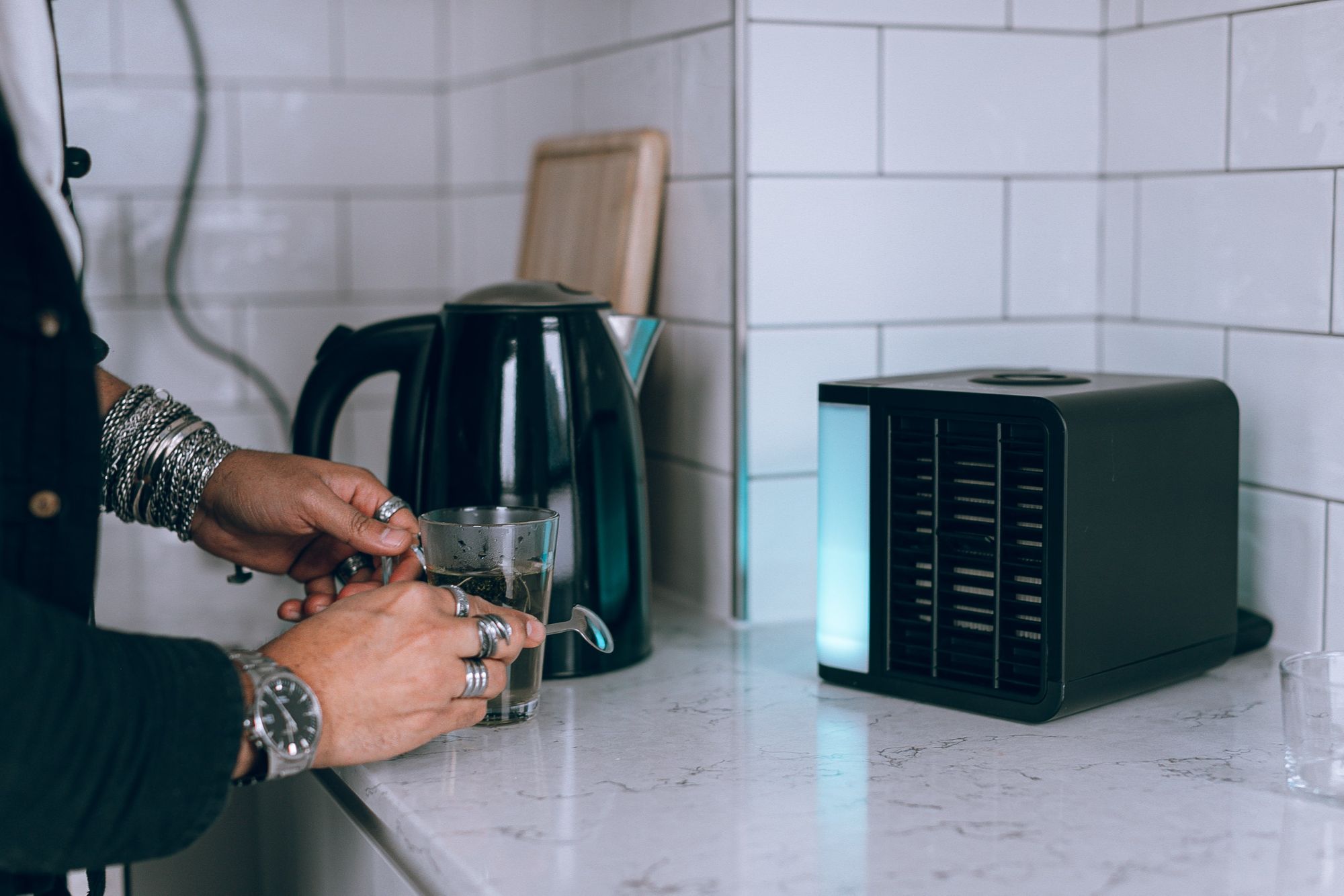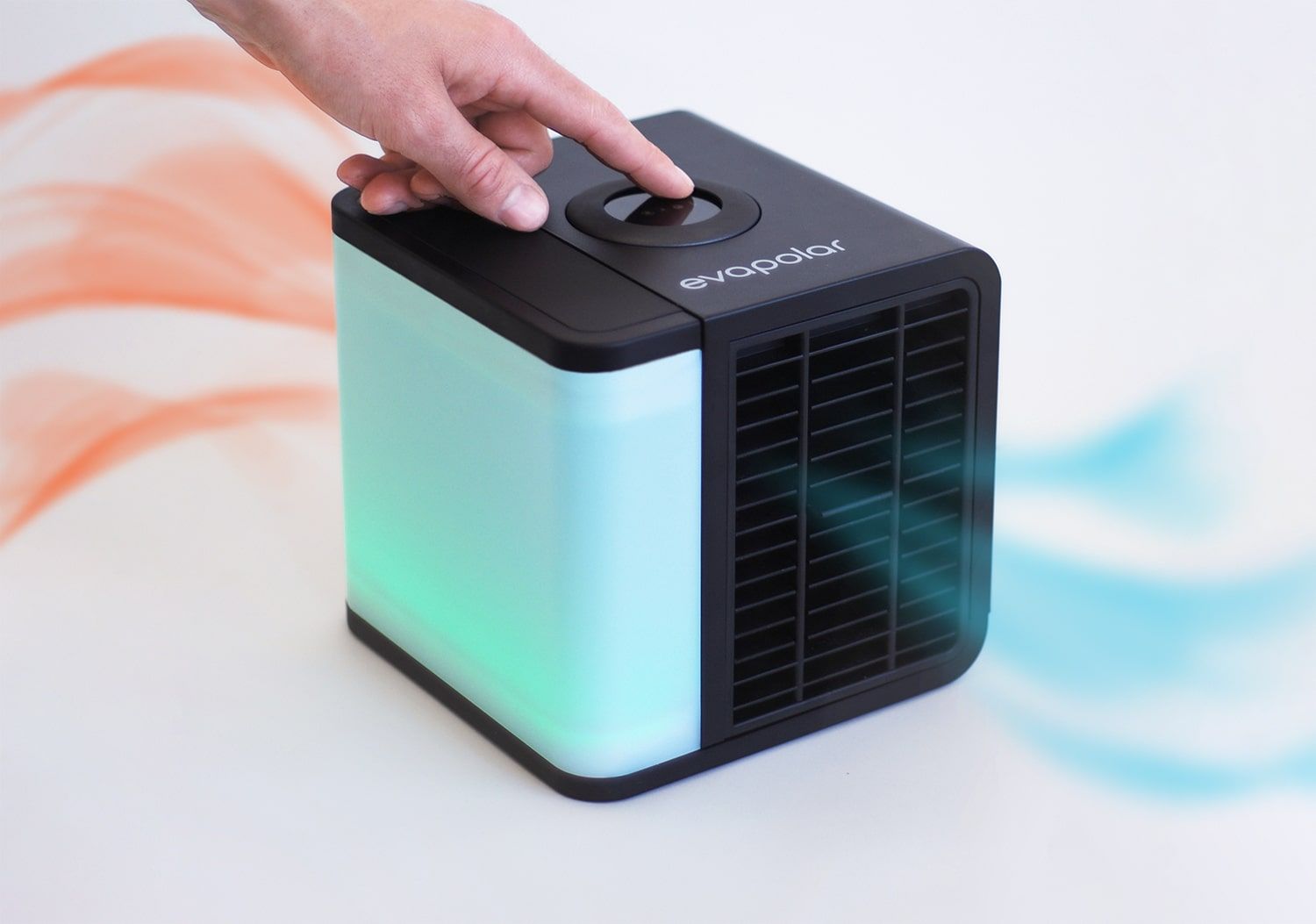It's getting hotter outside, and the electric bills are starting to go up. Are you looking for ways to stay cool while cutting down on expenses or an eco-friendly and cost-effective way to cool indoor and outdoor spaces? You have come to the right place because we will tell you exactly how to do it using an evaporative swamp cooler.
A swamp air cooler is a way better option than an expensive and not eco-friendly air conditioner.
We will take you through a comprehensive guide on these efficient home appliances with essential info on what they are, what they do, and what to consider before purchasing. Want to learn more? Let's dig in, and we promise that it will be cool!

evaCHILL
The most effective cooling device
Read Also: Safe Air Conditioner Alternatives for Cooling a Small Room
Content:
- What Is a Swamp Cooler? Mechanism and Benefits
- How Does a Swamp Cooler Work??
- Swamp Cooler Benefits
- Tips for Buying a Swamp Cooler
- What's the Difference Between a Swamp Cooler and an Air Conditioner?
- Best Swamp Coolers
- FAQ
What Is a Swamp Cooler? Mechanism and Benefits
It is a water-based cooling gadget that uses a technique as old as nature. Evaporative cooling is actually a natural phenomenon! Back in ancient Egypt, people used wet bedsheets to find relief in the scorching weather conditions. Thanks to physics, we now know that the temperature difference creates a mild wind that cools down the surroundings.
Can't you do that with a fan? No, because you also need water to affect the temperature. A swamp evaporative cooler combines the two variables, allowing you to lower the intensity of the heat in its vicinity.
How Do Evaporative Coolers Work?

Swamp coolers are built on one distinctive property of water — they can draw a good amount of heat to evaporate. During this process of liquid turning into vapor, the temperature of dry air can drop. We have a similar mechanism in our bodies whereby most of us sweat, which helps the body cool down when it's hot.
The swamp cooler makeup is pretty simple. It has either an inbuilt or detachable container for water that can be refilled with a water bottle or straight from the tap if you have good water running down your pipes. Specific builds also allow connecting it to a water pipe to get a continuous water supply. This option is more useful in window swamp coolers and other models made for bigger spaces.
There are two more key features in a swamp cooler — pads and a fan. The fan is there to power up the evaporation process and cool air delivery. In addition, a significant part of the device's insides is a pad, also called a cartridge or a filter, that provides a surface for evaporation.
The filter is usually from moisture-absorbing materials, like cellulose, though it's not the best choice for something that is often in contact with water.
Evapolar uses the unique patented evaBREEZE technology, which has no other alternatives and is the most efficient cooling material.

Read also: What’s the Best Fan for Sleeping?
Swamp Cooler Benefits
- Air quality
Evaporative coolers use water, and if it's the same quality as the water you drink, you have nothing to worry about. In addition, water is good at holding onto dust, which helps clear the air. Thanks to the additional water source, the gadget contributes to the air humidity, and a healthy humidity level indoors is always recommended.
- Cost
Swamp coolers are the best way to save money and stay cool in summer. They save almost 90% on energy costs compared to a basic AC. Moreover, the installation costs of AC are pretty steep, while with evaporative-type coolers, you just need to plug them in.
A swamp evaporative cooler is less expensive than an AC as well. Make sure you choose a high-quality version, though. A middle-range high-performance swamp cooler will last you many seasons.
- Ease of installation
The standard fitting of an air conditioner is complicated, expensive, and you cannot do it by yourself. Portable ACs are easier to install, but they are still large and don't fit all the spaces. Regular air conditioners require ductwork and refrigerant lines installed by a licensed contractor.
On the other hand, the swamp coolers just need to be attached to a water connection and plugged in. It is far more affordable and accessible than hiring a professional and paying them hundreds of dollars.
- Range of applications
A swamp cooler can be used anywhere in your living space, office, or anywhere else. Some models are heavier than others. For example, swamp coolers on wheels are not a problem to move them around and they can create a cooler environment anywhere.
When the heat is unbearable, and the air is dry, they work perfectly both indoors and outdoors in summer. You place it where you need, and your cooler blows air into a central location.
Swamp coolers are also available for use in industrial and commercial sectors. You can choose a swamp cooler for a larger space with a professional.
Read also: The Best Portable Air Cooler in 2021
Tips for Buying a Swamp Cooler
Before we move any further, it's worth noting that although swamp coolers are more affordable in the long run, they are made for drier climates. Plus, they come in such a variety of swamp cooler sizes and performance capabilities that there's quite a bit to consider before you find the one that suits your personal preferences, space availability, and mobility requirements.
1. Make Sure It’s Suitable for Your Climate
The primary factor to consider before buying an evaporative cooler is to make sure that your region's climate is suitable for one. For example, if you live in a humid environment, then a swamp cooler is not the best solution for you as it adds moisture to the air. Portable evaporative coolers work well in moderate climates and even better – in very dry climates.
If you live in a dry climate, these swamp coolers will make your summers dreamy — eradicating the heat and discomfort and making the environment pleasant.
As the swamp coolers add moisture to the air, they are excellent in hot, dry areas.
2. Consider What Size Swamp Cooler Do You Need
Many swamp cooler models aren't the smallest appliance you can have at home, so consider the measurements of each model against the space you have available. You can consider a personal swamp cooler which you can place on any available surface next to you.
The modern models fit in with any design.
You should also consider the CFM rating, i.e., the amount of air that passes from the cooler to your environment per minute. For example, if the size of your room is approximately 250 sq. ft., then the recommended CFM rating is 750 CFM.
You should look for a swamp cooler with higher CFM if your ceiling is higher than standard height or if the space is exposed to direct sunlight. Also, the more people are present in a particular area, the higher the CFM should be.
Any heat-generating appliance present in your room will also affect the performance of your cooler. Read more: Best Types of Room Air Conditioners That Really Get The Job Done
3. Compare Water Supply Options
When considering any swamp cooler model, look at its water supply system. Some coolers can be connected to a water pipe with a hose and use the same water as what comes through your pipes, while others use internal water containers as their source of moisture. You can, of course, find hybrid options.
Swamp coolers that can be directly connected are considered more suitable because you do not have to refill the tank, but they are expensive.
4. Estimate the Necessary Tank Size Based on Your Needs
If you opt for a small swamp cooler, they don't have a continuous water supply and instead come with a water tank. Its size will define how long a cooler can work— once the water runs out, most models work as an ordinary fan with no control of the temperature in its surroundings.
For example, the Evapolar models work up to 9 hours on one tank refill.
5. Choose an Optimal Set of Features
Swamp coolers are usually simple and don't have an elaborate design. However, there are just a few basic features you should keep in mind while buying them:
CFM rating — or how much space it can effectively cool down. This also affects power consumption.
Oscillation — constitutes the ability to move from side to side, affecting a wider territory.
Controls — some swamp coolers have digital controls, while some are manual.
Water level indicator — will let you know when your cooler is about to run out of water.
6. Study the Swamp Cooler Maintenance Recommendations
When it comes to the maintenance of swamp coolers, it is usually a three-step process that should take place at least once a month:
First, clean the outer surface of the cooler with a damp cloth.
Then, clean the evaporating system of the cooler with lukewarm water and a light detergent.
Finally, dry all parts before reassembling the cooler.
If you want to get the most benefits out of your swamp cooler, we recommend you open the windows, so the air doesn't get too humid — in this case, the device won't be able to evaporate water as efficiently. It's also more power-efficient when the air and water temperature are drastically different. Read also: Best ac for a dog house
What's the Difference Between a Swamp Cooler and an Air Conditioner?

Air conditioners contribute to the greenhouse effect, and if you do not clean them adequately, they will allow bacteria to grow in the air filters. The viruses in the AC filters can cause nasal congestions and frequent colds.
Furthermore, AC produces dry air, and spending long hours in AC air will dry your skin and make it sensitive. There are chances of leaking refrigerants in AC if not correctly used. On the other hand, swamp coolers are effective, safer, and reduce the temperature without causing any side effects.
Swamp coolers are also portable and easy to clean. The coolers are quieter than ACs and consume 75% less energy than a typical AC. Also, dry climates are best for evaporative coolers since they add extra humidity to the air.
A nice perk is that you can and should keep the windows open, letting in that fresh air. Instead, you need to bung up all the windows and even doors and breathe overprocessed air with an AC.
Also, you can check our article Swamp Cooler vs. Air Conditioner: What Is the Most Cost-Effective Option?
Key differences between a portable air cooler, an air conditioner, and a fan:
| Feature | Portable Air Cooler | Air Conditioner | Fan |
| Cooling Principle | Evaporative cooling; uses water | Refrigerant-based; removes heat from air | Circulates air without cooling it |
| Energy Efficiency | Generally more energy-efficient | Less energy-efficient | Most energy-efficient |
| Installation | No installation required | May require professional installation | No installation, plug-and-play |
| Portability | Easily portable | Fixed, though some portable versions exist | Very portable |
| Cost(Initial) | Generally cheaper than air conditioners | More expensive initially | Usually the cheapest option |
| Cost(Operating) | Lower than air conditioners | Higher due to refrigerant and compressor | Very low |
| Maintanance | Regular cleaning of water tanks/pads | Periodic professional maintenance | Minimal; occasional cleaning |
| Humidity Control | Adds humidity, not suitable for humid climates | Can reduce and control humidity | No impact on humidity |
| Noise Level | Can be quiet, but varies by model | Often quieter than coolers, but varies | Usually quiet, depends on model |
| Area coverage | Best for small to medium spaces | Can cover larger areas effectively | Best for immediate vicinity or small spaces |
| Ventilation Required | Needs fresh air supply for efficiency | Closed spaces preferred | |
| Climate Suitability | Best in dry climates | Suitable for all climates | Effective in all climates but doesn't cool air |
| Coolant Used | Water | Chemical refrigerants (CFCs, HCFCs, HFCs, or natural) | None |
| Enviromental Impact | Lower impact, uses water | Higher impact due to refrigerants | Minimal impact, uses only electricity |
| Additional Features | Can sometimes double as humidifier | Often includes air filtering and dehumidifying | Some models have ionizers or purifiers |
Best Swamp Coolers
Here are a few examples so you can see how different-sized models for different purposes compare.
Evapolar — Personal Evaporative Air Cooler

The Evapolar is a smart and innovative air cooler designed to cool down your personal space. The small portable swamp cooler cools, moisturizes, filters dust particles from the air, and makes it healthy for breathing.
This cooler is easy to understand and maintain. Simply plug it in with a USB cord either to a socket or a power bank and enjoy. You can simply use it as a fan if you do not fill the tank with water. The patented evaBREEZE material makes it unique and very efficient.
It is also very affordable, starting at $99.
MasterCool 4000 CFM — Window Swamp Cooler
It is a heavy-duty window air cooler intended to cool down an area of 2000 sq. ft. and runs from 115 Volts, which is enough to reduce the temperature in a single room. The outer body is rust- and UV light-resistant.
The water pipe is fitted in the cooler for a continuous supply. It is pretty expensive, though, starting from $685. Moreover, it is heavy and not portable.
Hessaire 3100 CFM - Outdoor Swamp Cooler
The Hessaire Swamp Cooler is also large, but it is portable since it has four caster wheels. The Hessaire efficiently cools up to 950 sq. ft. of space. It is primarily designed for outdoor use. It has heavy-duty fans and oscillating louvers to ensure the proper distribution of cool air throughout the area.
The water tank can hold enough for three to four hours of runtime. It has three-sided cooling pads and generates cool, fresh air. The prices of this swamp cooler start from $379.
Why Choose the Evapolar Compact Air Cooler?
There are various options on the market when it comes to swamp coolers. However, most of them are bulky. Instead, the Evapolar air cooler is exceptionally efficient for cooling your personal space and has several advantages over other swamp coolers:
It uses an innovative patented evaBREEZE material for swamp cooler filters. It is a non-organic nanomaterial that provides a better surface for evaporation. In addition, this material prevents the growth of bacteria and molds, unlike cellulose filters.
High-quality materials. Evapolar is made from durable plastic that doesn’t emit a nasty smell. The patented material helps not only to cool but also to purify the air.
Perfect sizing. You can place it in your bedroom, office, or anywhere. It is quiet, and you can get your beauty sleep without any distractions.
Personal comfort. It cools the person sitting next to it, it doesn’t cool your home to save energy. The compact size of the cooler allows you to place it on your bedside table while you sleep. It has a noiseless operation, and the faint white noise it produces helps people relax and fall asleep.
Wrap Up
Swamp coolers are an effective, eco-friendly, and affordable way to bring the temperatures down. They work best in a dry and hot climate area. You should make sure to check the CFM rating, coverage area, and a few other features before buying one.

The Evapolar swamp cooler will allow you to cool your personal space without any worries. It has a reasonable cost and uses innovative technology. Moreover, it is environmentally safe. So buy a swamp cooler for your home or office and enjoy working in a cool and calm place.
FAQ:
- What is a swamp cooler and how does it work?
A swamp cooler, also known as an evaporative cooler, is a device that cools air through the evaporation of water. It works by pulling warm outside air through wet pads, where the air is cooled by evaporation and then circulated into your living space.
2. Where are swamp coolers most effective?
Swamp coolers are most effective in hot, dry climates. They rely on the evaporation process, which is more efficient when the air has a low humidity level. In areas with high humidity, their cooling effect is significantly reduced.
3. Can I use a swamp cooler in an indoor space without windows or doors open?
No, swamp coolers require a constant flow of fresh air to operate effectively. Without ventilation, the room can become overly humid and the cooling effect will diminish. It's best to crack open a window or door to allow for air exchange.
4. Are swamp coolers energy-efficient?
Yes, swamp coolers are generally more energy-efficient than conventional air conditioners because they use the natural process of evaporation for cooling and do not require refrigerants or compressors.
5. Does a swamp cooler add moisture to the air?
Yes, as part of the cooling process, swamp coolers add humidity to the air. This can be a benefit in very dry climates, but it can be a drawback in areas that already have high humidity.


